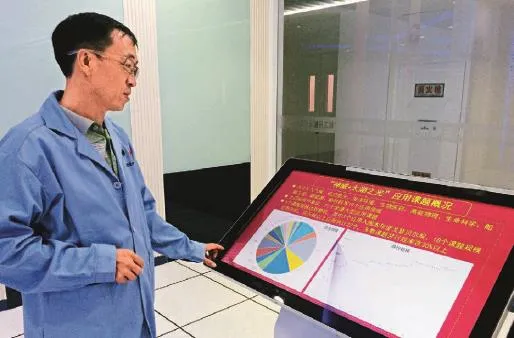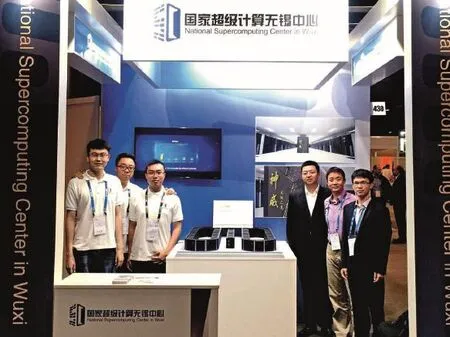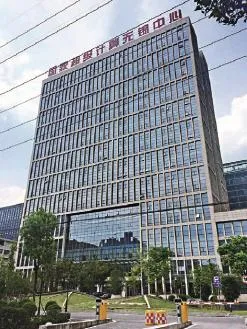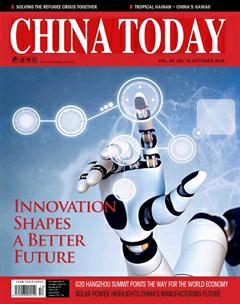Yang Guangwen: Builder of the Most Powerful Computer
By staff reporter LU RUCAI
Yang Guangwen: Builder of the Most Powerful Computer
By staff reporter LU RUCAI
AT the International Supercomputing Conference held in Frankfurt, Germany on June 20, 2016, the TOP500.org published the latest supercomputer rankings. China’s Sunway TaihuLight took pole position.
This is the seventh time in a row that China’s supercomputers have topped the Top500 rankings, published biannually since 1993. Chinese-made Tianhe-2A, which came first last year, was second on the latest list.
“Sunway TaihuLight is the first supercomputer with a processor independently developed by China, and showcases our level in designing and manufacturing highperformance computers,” said Tsinghua University professor Yang Guang-wen,director of the National Supercomputing Center in Wuxi where Sunway was produced. “We are now one of the forerunners in this field, rather than runnerup to developed countries such as the U.S. and Japan,” Yang added.
National Strategy
Before Sunway was unveiled last June,visitors were prohibited from the National Supercomputing Center labs in Wuxi. The ban has now been lifted, but visitors must be accompanied by an authorized technician. Our reporter was instructed to wear the white coat bearing the Sunway logo and the name of the center - a reminder that we were approaching the world’s most powerful computing system.
Born in 1963, leading scientist Yang Guangwen started researching supercomputing as early as 1994. He was selected for the expert panel of the “863 Program” in 2002.
The “863 Program” is a special national program dedicated to improving China’s capacity for independent development of cutting-edge technology. Initiated in March 1986, it is referred to as“863.”

Yang Guangwen explains the applications of the Sunway TaihuLight.
FORERUNNER
" We are now one of the forerunners in this field,rather than runner-up to developed countries such as the U.S. and Japan. "
In 1983, three years before the program started, China developed Yinhe-1, the first supercomputer in the country capable of computing 100 million times per second. It marked China’s entry into the supercomputing club, but there was still a large gap between China and other leading countries.
The National University of Defense Technology developed Yinhe-1A in 2009. It ranked first on the TOP500 list with a theoretical peak performance of 4.701 petaFLOPS. Later, Tianhe-2 retained its top slot six consecutive times until Sunway took over.
“It took only two years to develop the Sunway TaihuLight,” said Yang Guangwen, “because we had accumulated decades of experience in this field.” Sunway’s biggest plus is that it uses Chinesedesigned chips, and the software and applications are developed and manu-factured independently. “And our supercomputer consumes lower energy,” Yang added.
Sunway TaihuLight is the world’s first system with a peak performance greater than 100 petaFLOPS. It has a LINPACK benchmark rating of 93 petaFLOPS,three times that of Tianhe-2.
Sunway is also one of the most energy-efficient supercomputers, at 605.130 MFLOPS per watt. “Compared to the best systems in the U.S. and Japan, Sunway has achieved energy consumption three times as efficient,” said Fu Haohuan, associate professor at the Center for Earth Systems Science at Tsinghua University,and vice director of the National Supercomputing Center in Wuxi.
“The entire system is composed of 40,000 chips, with 260 cores on each chip,” Fu explained. He led the team which unveiled the Sunway TaihuLight system in Frankfurt in June.“That this giant system runs on such low energy is a great innovation.” Fu recalled how many experts from other countries were astounded.
In addition, the total amount invested in Sunway is only RMB 1.8 billion. “This is another jaw-dropping fact for foreign experts,” said Fu Haohuan.
“Building supercomputers was a national initiative,” said Yang Guangwen,“whether it made money or not.” Since the “863 Program” was launched, China has made developing high-performance computers a priority. “I think one reason is the desire to break the blockade from other countries.” Yang recalled how machines imported from the U.S. could only be used under American “guidance.” “It felt like a slap in the face,” he said.
In 2015, the Tianhe-2 development team was forced to change their original R&D path because of an embargo on Intel chips from the U.S. In contrast, all research and development for the Sunway TaihuLight (initiated at the same time as Tianhe-2) was done in China.
“The country is calling for innovation,especially in technology,” Yang said.“We developed a complete plan in the field of supercomputing, so were able to break through the U.S. technological barrier.”
On July 15, the Sunway TaihuLight was recorded in the Guinness Book of World Records as the World’s Fastest Computer. Rowan Simons, president of Guinness World Records, Greater China, presented the certificate to Yang Guangwen, calling it “a historic breakthrough for China in the field of supercomputing.”
At present, the demand for supercomputing in China is enormous. The supercomputer Yang Guangwen is in charge of at Tsinghua University supports over 200 tech teams from 35 colleges and departments who have published more than 100 world-class theses. Yang believes the demand will be even greater in areas such as national security, aerospace, weather and climate,industrial manufacturing, and pharmaceuticals. This is one reason why China is sparing no effort in this field.

Sunway team members in their booth at the 2016 International Supercomputing Conference in Frankfurt.
Applications
Fu Haohuan returned from Stanford to teach at Tsinghua in late 2010 when Tianhe-1A had just taken first place on the TOP500. His Tsinghua colleague told him that an American scientist had asked: “You got first place, but how about your applications? Can you make full use of the system?”
“There is a lot of skepticism about China’s supercomputing,” Fu said. The CPU and chips were imported from the U.S, which means the Tianhe-2 reflects a high capacity for integration. However,more attention should be paid to whether it can facilitate applications and solve scientific problems.
Taking applications into consideration, the National Supercomputing Center in Wuxi insisted on tackling both tasks at the same time - testing the machine and developing applications -from the very start.
In just over six months from when trials began in December 2015, over 60 applications have been developed in 19 areas, including weather and climate;aerospace; marine environment; biomedicine; marine engineering; new materials; and advanced manufacturing.
Among these, three projects have been nominated for the Gordon BellPrize, an award presented by the Association for Computing Machinery. They are: A Highly Effective Global Surface Wave Numerical Simulation with Ultra-High Resolution; Extreme-Scale Phase Field Simulations of Coarsening Dynamics on the Sunway TaihuLight Supercomputer;and 10M-Core Scalable Fully-Implicit Solver for Nonhydrostatic Atmospheric Dynamics.
The Gordon Bell Award, established in 1987, is the world’s most prestigious award in high-performance computing applications. American scientific groups consistently won the award for the first 20 years, until Japan’s Earth Simulator won the prize in 2002. In recent years, the prize has been monopolized by the U.S. and Japan with occasional wins by European institutions. Chinese scientific teams have not made the shortlist until this year, which Fu called “inspiring.”
Participants in the application projects had personal experience of the calculation capacity of Sunway TaihuLight. The National Laboratory for Computational Fluid Dynamics completed largescale parallel computing on the Sunway TaihuLight in just 20 days - a process which used to take as long as 12 months. The results were also in accordance with wind tunnel test results.
Vital to Upgrade Manufacturing
The National Supercomputing Center was established in Wuxi, a city in Jiangsu Province, east China. Jiangsu is one of the country’s biggest manufacturing bases. The center was set up here,Yang Guangwen said, in order to transform manufacturing in the province.
An area forming only 1 percent of China’s territory, Jiangsu contributes around one tenth of the country’s GDP. Upgrading and transforming Jiangsu’s manufacturing is of great value to other provinces.
To build the center, Jiangsu’s provincial government and Wuxi’s municipal government each respectively invested RMB 600 million, and gave Tsinghua University responsibility for its operation.
“Made in China 2025,” an initiative recently launched by the Chinese government, focuses on high design level. Yang Guangwen commented:“Only if the design level improves can the manufacturing standard be raised.”The design and simulation process in the post-manufacturing stage cannot be conducted without the use of supercomputers. “We are trying to build a base for industrial and technological innovation,”Yang said.

The office building of the National Supercomputing Center in Wuxi.
It is no easy task. Many companies currently use copycat or manual design,and the simulation and design software market is dominated by imported commercial products.
“What we are going to do is simulation and design in bulk,” Yang explained. In the car manufacturing sector, for example, destructive collision tests are used for safety testing. “Now we can use the supercomputer to do a numerical simulation,” Yang said, “which will cut down on experimental loss and shorten the cycle.”
The same concept can also be used in aircraft manufacturing and performance tracking. “The supercomputers are able to analyze data collected by the sensor, thus making it possible to timely spot problems and potential threats in performance, so reducing the probability of accidents.” Yang hopes to tap the supercomputer’s potential and build a complete industrial chain from design and manufacturing to data analysis.“Combining supercomputing and big data can efficiently manage the entire product lifecycle.”
But a more urgent problem for Yang is finding long-term industrial clients, for example, key national projects or important manufacturers. He believes Sunway TaihuLight can help clients to develop their own core parallel software, which will assuredly upgrade lower-reach manufacturing.
China is currently the world leader in terms of supercomputer quantity, with 167 Chinese supercomputers listed in the TOP500 rankings. The U.S. is a close second. In terms of application,however, China still lags behind. “It will take a long time to close the gap, and we need to promote applications among companies with demand,” Yang said. In China the R&D team is mainly composed of computing scientists, while in foreign countries up to two thirds are application developers.
One of six supercomputing centers in China, the National Supercomputing Center in Wuxi hopes to provide programs, models and other resources in order to establish labs jointly with application institutions, thus to expand the scale of application.
“China has invested hugely in scientific and technological research, even surpassing the U.S. in some fields,” said Fu Haohuan, “so many researchers then working overseas returned to complete their projects in China, as here they can find the resources they could only long for in other countries.” Fu said China believes science and technology will play a huge role in future, and the idea itself serves to promote the sector’s development.
“We can build world-class high-speed railways, but the fluid design and most of the software for simulation is commercial software imported from other countries,” Fu Haohuan said. “Developing our own software is a problem we need to tackle. Now we can try by using world’s fastest computer. Isn’t that a great opportunity?”

